The Potential of VR/AR to Revolutionise Electronics Manufacturing
VR and AR offer significant advantages in the design, testing, validation and production of electronic components and systems, says Milton D’Silva.
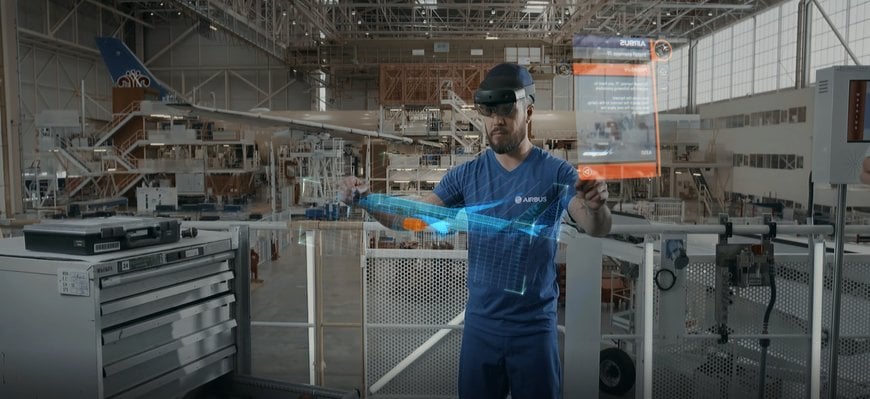
Microsoft holographic technology helps Airbus manufacture more aircraft faster. Photo: Microsoft
The electronics manufacturing industry today is the cornerstone of the global economy, influencing numerous industries and aspects of daily life. It drives technological progress, creates jobs, and connects the world through a diverse range of products and innovations. The industry's growth and sustainability are closely tied to its ability to adapt to changing technologies and market demands while addressing environmental and social considerations. Advances in electronics manufacturing have led to the development of cutting-edge products and technologies, including smartphones, computers, medical devices, renewable energy systems, and much more. These innovations have transformed various industries and improved the quality of life for people around the world. A recent meme that went viral on social media has listed the scores of electronic devices and gadgets the ubiquitous smartphone has replaced. But what it does not mention is the plethora of even more hi-tech products that are churned out at double speed to feed the growing appetite for next gen appliances and devices that keep the world of electronics manufacturing busier than ever.
According to Statista, the global data and business intelligence platform, revenue in the electronics market is estimated to reach US$837.20bn in 2023, and is expected to show an annual growth rate of 12.62%, resulting in a projected market volume of US$1,347.00bn by 2027. This kind of humongous growth potential calls for revolutionary manufacturing technologies in an era of shrinking product development cycles and the clamour for faster time to market. Moreover, the electronics manufacturing industry has a complex and global supply chain. It involves the sourcing of materials and components from various countries, often requiring coordination between multiple suppliers. The efficient management of this supply chain is crucial for timely production and product quality. This also means electronic products are among the most exported goods in the world. Countries with strong electronics manufacturing sectors often rely on exports to drive their economies. This includes both finished products and electronic components.
Though the terms Virtual Reality (VR) and Augmented Reality (AR) were coined only in 1987 and 1990 respectively, the ‘experiences’ represented by these have been around for several decades prior to these becoming mainstream in the digital era. To give a brief idea to the uninitiated, Virtual Reality or VR is a computer-generated virtual environment in which the viewer is immersed, and can interact with the scene as part of it, though nothing is real, just a simulation. On the other hand, in Augmented Reality or AR, digital content is overlaid on actual objects or machines, buildings, etc., in the form of text, sound or graphics. The viewer can interact with the scene by pointing out the smartphone or tablet camera on it. There is also Mixed Reality or MR, which combines the experiences of VR and AR with interactive features. Finally, there is XR or eXtended Reality, which brings together VR, AR and MR, combining all real-and-virtual environments to provide 360-degree image-based, extended reality experiences that can be accessed through a web browser (WebXR – the new application programming interface introduced in 2018).
At a recent Innovation Day event of a global technology major, the company’s digital head quoted an article from a business magazine that stated the metaverse is dead. It was dead on arrival, he added. Before the shocked audience could react, the slide on the screen changed and declared that though the metaverse is dead, the industrial metaverse is alive and kicking. In fact it is among the fastest growing trends globally. Within the industrial metaverse, VR/AR is a significant link in bridging the virtual and physical worlds. ABB, for example, believes the Industrial Metaverse can be pictured as an emerging user-centred space that connects and enhances the digital and physical worlds by integrating various recent technological trends such as digital twins, machine learning, the Internet of Things (IoT), mixed reality and 5G. As the idea of the industrial metaverse is increasingly being accepted by manufacturing companies, it is facilitating high levels of connectivity and data analytics, bridging the highly immersive virtual world with physical reality. After years of dominating the gaming industry, VR and AR are finally finding their rightful place in the manufacturing domain.
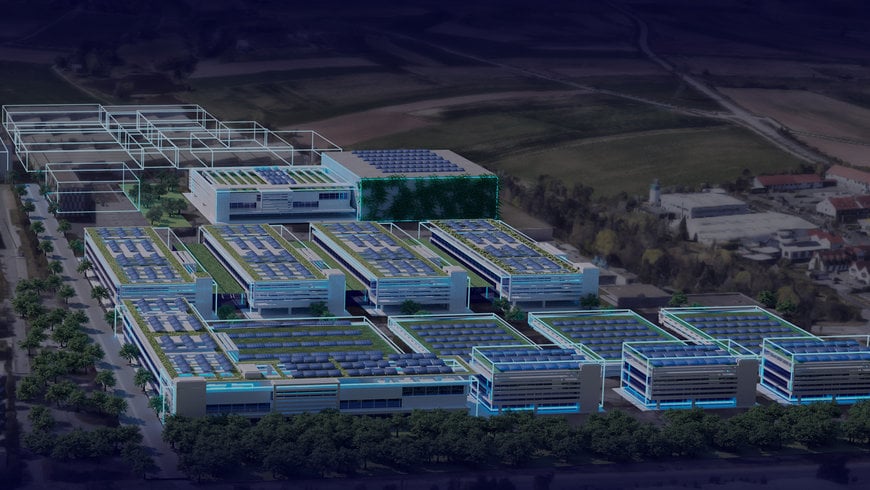
The proposed Siemens campus will serve as a global development and manufacturing hub for the industrial metaverse. Photo: Siemens
The origins of VR/AR in manufacturing
The use of digital technologies like VR/AR in manufacturing is not an overnight development. It has been happening gradually over the last three decades. Back in 1990, Alan Mulally, then Director of Engineering at Boeing, took a bold step with the decision to develop their new aircraft, the Boeing 777, completely on computers, eliminating blueprints altogether. While Boeing and other aircraft manufacturers were using Computer Aided Design (CAD) in their design process for years, never had any company developed an aircraft entirely in the digital space until then. Making use of 3D CAD software tools from Dassault Systèmes and IBM, the Boeing 777 was the world’s first 100% digitally designed aircraft, defying all sceptics. Since Boeing itself was not very sure, one physical mock-up was made, that of the nose section, to validate the software design. The results were convincing enough to cancel all other mock-ups, including the highly expensive full aircraft mock-up, a first in the case of a commercial airliner.
Another remarkable thing about the 777 was that it was the first commercial aircraft designed with inputs from 8 leading airlines of the world regarding the seating capacity and configuration and range. A commercial aircraft of that size contains hundreds of sub-assemblies and millions of individual parts, all of them tested virtually. The end result was an aircraft that was more advanced aerodynamically and structurally stronger, with better fuel economy. Mulally, who later joined Ford Motors and had a highly successful tenure (2006-16), is credited for turning around the beleaguered automobile company using similar digital strategies. By then, many other aircraft and automobile companies had started implementing VR and 3D digital tools in designing new aircraft, vehicles and parts. The new kid on the digital block had truly arrived.
VR/AR in electronics manufacturing
Today consumers want greater innovation in their products with better aesthetics and customisation, and expect them to be made available at competitive prices. Manufacturers, on the other hand, also have to worry about safety on the shop floor in increasingly automated workplaces, while fulfilling customer expectations. These are precisely the attributes VR/AR bring to the table, such as faster development cycles, increased efficiency, reduced costs, and improved safety – attributes that were always desirable in any manufacturing activity, but something that technology has now not only made feasible, but more importantly, accessible to everyone.
Virtual reality – the new age design tool
Virtual reality can play a significant role in designing electronic products by offering engineers and designers immersive and interactive tools that enhance the design, development, and testing processes.
There are several ways in which VR can benefit electronic product design:
- Visualising and prototyping: VR allows designers to create three-dimensional virtual prototypes of electronic products. This enables them to visualise the design from various angles and gain a better understanding of the form and aesthetics of the product. Designers can quickly iterate and experiment with different designs in a virtual environment, saving time and resources that would have been spent on physical prototypes.
- Ergonomics and human factors: VR can simulate the user experience and ergonomics of electronic products. Designers can test the comfort and usability of a device by placing themselves in a virtual environment and interacting with the virtual product, helping identify potential issues and improvements.
- Collaboration: VR can facilitate remote collaboration among geographically dispersed design teams. Designers can meet in a shared virtual space to discuss and make real-time design decisions, improving communication and productivity.
- Simulation and testing: Engineers can use VR to simulate the behaviour and performance of electronic components and systems. This can help in identifying potential issues, optimising performance, and reducing the need for physical testing and experimentation. VR can also simulate the effects of various environmental conditions, such as heat, cold, vibration, and electromagnetic interference, to test how the electronic product performs under different circumstances.
- Training and skill development: VR can be used to train engineers and technicians in the assembly, repair, and maintenance of electronic products. Virtual training environments can provide a safe and controlled space for learning and skill development.
- User experience: VR can be employed to create and test user interfaces and interactions for electronic products. Designers can immerse themselves in a VR environment to evaluate the user experience and make necessary adjustments.
- Marketing and sales: VR can be used to create immersive product demonstrations and marketing materials. Potential customers can experience the product in a virtual setting, which can help in generating interest and understanding its features and benefits.
- Cost reduction: By identifying design flaws, potential issues, and improvements early in the design process, VR can help reduce the cost of physical prototyping, testing, and iterations. Above all, there is no need to use any paper for documentation as everything is stored digitally.
- Data visualisation: VR can help in visualising complex data related to electronic product design, such as circuit diagrams, 3D models, and performance metrics, making it easier for designers and engineers to analyse and make informed decisions.
- Accessibility and inclusivity: VR can be used to simulate the user experience for individuals with different physical abilities or impairments, ensuring that electronic products are designed with accessibility and inclusivity in mind.
How AR helps in manufacturing
Augmented reality can play a valuable role in the manufacturing of electronic products by providing real-time, interactive, and visual information that aids workers, engineers, and technicians in various aspects of the manufacturing process.
Here are some ways in which AR helps in electronic product manufacturing:
- Assembly instructions: AR can overlay step-by-step assembly instructions and diagrams onto the physical components, helping workers in the assembly line to follow instructions accurately, reducing errors, and improving assembly efficiency.
- Quality control and inspection: AR can assist in quality control and inspection processes by overlaying digital indicators, such as tolerance ranges or defect detection criteria, on physical components. This helps inspectors identify and rectify issues promptly.
- Maintenance and repair: AR can provide technicians with real-time guidance and diagnostic information when they are repairing or maintaining electronic products. This can reduce downtime and improve the accuracy of repairs.
- Training and onboarding: AR can be used for training new employees by offering interactive and immersive on-the-job training experiences. New workers can learn how to operate machinery, troubleshoot issues, and follow safety protocols using AR simulations.
- Remote expert support: Technicians working on electronic products can wear AR headsets that allow them to connect with remote experts. These experts can see what the technician sees, provide guidance, and even draw annotations in the technician's field of view, facilitating problem-solving and reducing the need for on-site visits.
- Inventory management: AR can assist in managing inventory by providing real-time data on the availability and location of electronic components, reducing the chances of errors in picking parts for assembly.
- Design review and collaboration: Design engineers can use AR to review and collaborate on 3D models and schematics, making it easier to spot design flaws, conduct virtual design reviews, and make design adjustments in real time.
- Ergonomics and workflow optimisation: AR can help in analysing and optimising the ergonomics of workstations and assembly processes. By simulating different layouts and workflows in augmented reality, manufacturers can design more efficient and worker-friendly production lines.
- Workplace safety: AR can provide real-time safety warnings and reminders, such as highlighting restricted areas, indicating safe pathways, and showing safety guidelines to ensure that workers adhere to safety protocols.
- Data visualisation: AR can display data and metrics in a visually intuitive manner, helping operators and managers make informed decisions and monitor the performance of manufacturing processes.
- Customisation and personalisation: In the manufacturing of custom electronic products, AR can assist workers in following specific customer requirements, ensuring that each product meets the desired specifications.
- Reducing error rates: By providing real-time guidance and instructions, AR can significantly reduce error rates in manufacturing, improving the overall quality of electronic products.
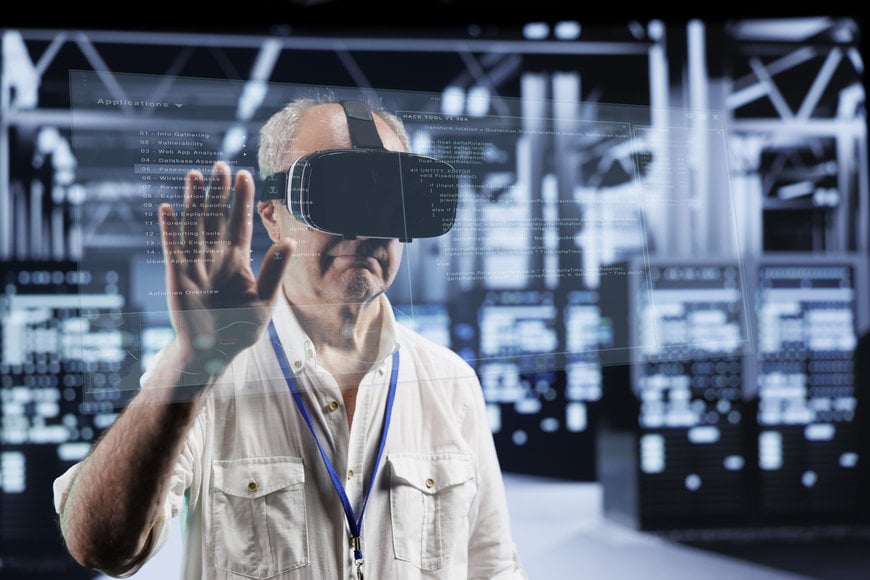
VR can be used to train engineers and technicians. Image by DCStudio on Freepik
Leading vendors
With the advantages that VR/AR offers in manufacturing, there are several companies ranging from tech giants to small startups that offer products and services, including full scale ‘platforms’ that offer a complete manufacturing ecosystem connecting the virtual universe with the physical world.
Dassault Systèmes, the company that helped Boeing design the 777 in the Nineties, later introduced the ‘3DEXPERIENCE’ platform in 2012 for manufacturing companies with the ‘virtual twin experiences’. The 3DEXPERIENCE platform brings together iconic brands like SolidWorks, Delmia, Simulia, Geovia, Netvibes, among others, that offer end to end services for different industry verticals. Delmia is the industrial design and simulation software that can be used in conjunction with AR and VR technologies for manufacturing and product design. Through a virtual twin experience, it virtually demonstrates what can be implemented and executed in the real world through modeling, simulation and visualisation – from manufacturing production, plant layout, operations, and logistics – across the entire supply chain.
Siemens offers Teamcenter VR, with virtual reality embedded into PLM, enabling users to make smarter decisions around products. Teamcenter VR enables virtual prototyping that includes interaction with the digital twin at any scale, with just a single click from launch for an immersive user experience. Similarly, the company offers Solid Edge Augmented Reality platform that brings ideas to life with design visualisation, to enable users to experience true-scale digital prototypes in real-world environments, connecting the digital environment with the physical world. In addition, Siemens has also launched the Xcelerator – a new, open digital business platform featuring a curated portfolio of IoT-enabled hardware and software, with a powerful ecosystem of partners, and a marketplace – to accelerate digital transformation. The Xcelerator has partnered with NVIDIA to build the Industrial Metaverse, where all reality experiences converge to enable manufacturing from concept to production and beyond. Just a few months ago, Siemens announced its plan to invest €1 billion in Germany and create a blueprint for an industrial metaverse in the Nuremberg metropolitan region.
Schneider Electric launched EcoStruxure in 2016, an open IoT-enabled architecture and platform that allows organisations to leverage connected devices, sensors and other things. Later the company introduced new augmented reality (AR) software, the EcoStruxure Augmented Operator Advisor. The solution brings together physical, real-life objects with virtual objects to increase operational efficiency, reduce costs and improve proactive maintenance. This custom application improves operational efficiency with augmented reality, enabling operators to superimpose current data and virtual objects onto a cabinet, machine, or plant. It combines contextual and local dynamic information for mobile users, enabling them to experience a fusion of the physical, real-life environment with virtual objects.
Bosch offers VR/AR – digital reality solutions for enterprises, for factories of the future. The company’s Engineering Design Solution enables workers to assess design ideas virtually. It assists greatly in identifying the early design defects and thereby helps in cost savings. It also reduces huge prototyping costs; offers immersive experience to interact with a future product/concept car with just available 3D CAD content; and saves huge prototyping costs and helps extensively in validating user experience, design reviews across geographies with just engineering 3D digital content as input. These solutions can be seamlessly deployed onto multiple platforms.
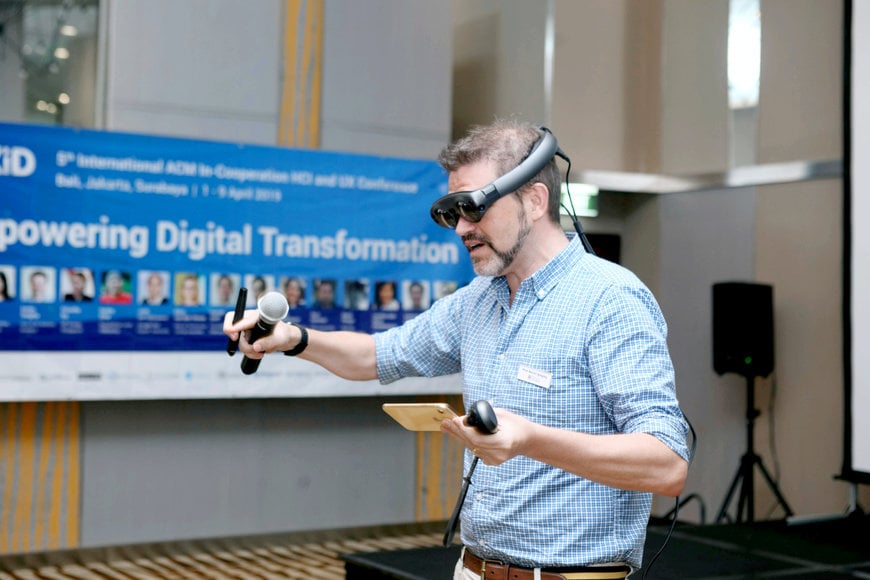
Driving digital transformation with augmented reality. Photo: Schneider Electric
Apart from these examples above, there are many other vendors of full scale VR/AR services for manufacturing, or companies providing hardware and accessories that enable them:
- Microsoft HoloLens is a widely recognised and used AR headset that has applications in manufacturing, enabling workers to overlay digital information onto the physical world.
- Trimble offers DAQRI Smart Glasses (DAQRI was acquired by Trimble) with applications in industrial and manufacturing settings.
- PTC's Vuforia platform provides AR solutions for various industries, including manufacturing. It's known for its computer vision and tracking capabilities.
- Qualcomm’s Snapdragon XR platform has powered numerous AR and VR devices, offering efficient and immersive experiences. Their Snapdragon XR2 chipset has been instrumental in delivering high-performance and low-latency experiences to a broad range of headsets.
- Magic Leap focuses on mixed reality and offers solutions for enterprise applications, including manufacturing and design.
- NVIDIA’s powerful GPUs and software solutions have been instrumental in driving the graphical capabilities of AR and VR experiences. Their advancements in real-time rendering and ray tracing technology have significantly enhanced visual fidelity in virtual environments.
- Unity MARS (Mixed and Augmented Reality Studio) is a widely used game engine that has also expanded into the AR/VR space, with tools for creating industrial AR applications.
- PTC's Vuforia platform offers AR solutions for manufacturing, including industrial maintenance and remote assistance.
- Scope AR's WorkLink platform is designed for enterprise AR applications, and it's used in manufacturing for tasks like remote assistance and training.
- Oculus, owned by Facebook (now Meta), provides VR solutions that have applications in training and simulation for manufacturing industries.
- Virtalis offers immersive VR solutions for engineering and manufacturing applications.
- Eon Reality provides VR and AR solutions for education and industry, including manufacturing and training applications.
- Epson's Moverio smart glasses are used for a range of AR applications, including in manufacturing and industrial maintenance.
- India-based Fusion VR, an emerging metaverse development company, handholds clients deploying the Industry 4.0 suite of VR, AR, MR and Immersive Digital Twin technologies. It provides digital-twins, training simulators, remote assistance solutions, smart visualisation solutions, sales, marketing and customer service solutions for a wide spectrum of industries.
The other side of technology
Though VR and AR have gained significant interest and adoption in the manufacturing industry, offering numerous benefits, there are also some potential pitfalls and challenges associated with their use in manufacturing. These can be summarised as:
- Cost – The foremost among these is the cost of implementation as VR/AR systems can be expensive to purchase and set up. This includes the cost of the hardware, software development, and training for employees.
- Integration – Integrating VR/AR into existing manufacturing processes and systems can be complex. Compatibility issues with legacy systems may arise, leading to additional costs and time delays.
- Technical issues – VR/AR hardware and software may require frequent updates and maintenance, which can be a strain on resources. Technical glitches, latency issues, and system crashes can disrupt production.
- Training and skill gaps – While VR/AR can enhance training and skill development, there's a learning curve for employees who need to become proficient in using these technologies. Training can be time-consuming and costly.
- Health and safety concerns – Extended use of VR headsets can lead to discomfort or health issues such as motion sickness, eye strain, and neck pain. Adequate precautions and regular breaks are necessary.
Besides these, there are the usual concerns about data security like potential breaches and cyberattacks that may require additional security measures. Sharing manufacturing information through VR/AR could pose intellectual property and data leakage risks. As of now, the availability of specialised VR/AR applications for manufacturing may be limited in the absence of enough use cases. There is also the usual resistance to change from employees, when it comes to adopting new technologies, especially from older workers, which can be a hurdle.
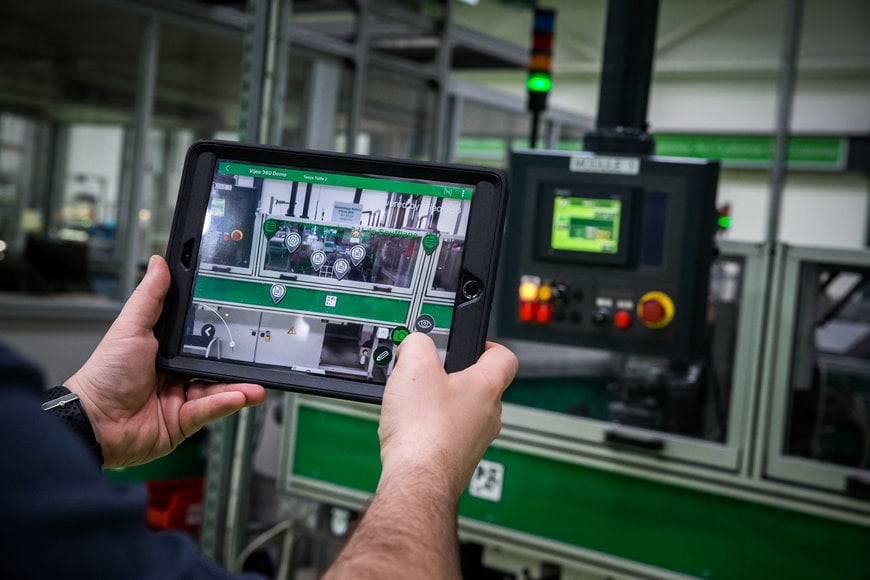
Despite these pitfalls, VR and AR offer significant advantages in manufacturing, such as improved training, remote collaboration, reduced errors, and enhanced visualisation of complex processes.
Conclusion
In conclusion, virtual reality can significantly enhance the design and development of electronic products by providing a range of tools and capabilities that improve visualisation, collaboration, testing, and user experience design, while also reducing costs and time to market. Augmented reality enhances electronic product manufacturing by improving efficiency, accuracy, training, collaboration, and safety. It empowers workers with real-time information, instructions, and support, ultimately contributing to better product quality and productivity in the manufacturing process. To successfully implement VR/AR, manufacturers must carefully evaluate their specific needs and address these challenges through proper planning and investment. Also it is important to note that the landscape of VR and AR technology vendors is dynamic, and new players are emerging. While virtual, augmented and mixed reality (VR/AR/MR) devices promise to revolutionise the way we interact, acting as gateways to the metaverse, a lot of development is still required to meet the growing demand of the industrial metaverse.
References
1. https://en.wikipedia.org/wiki/Boeing_777
2. https://www.vyrian.com/how-is-virtual-reality-changing-the-playground-for-the-electronic-industry-explained/
3. https://www.3ds.com/products/delmia/virtual-twin-manufacturing
4. https://solidedge.siemens.com/en/solutions/products/cloud-based-collaboration/teamcenter-share/augmented-reality/#ui-design-collaboration
5. https://www.bosch-softwaretechnologies.com/en/services/enterprise-services/manufacturing-excellence/arvr/

